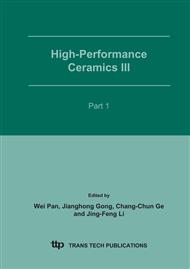p.31
p.35
p.39
p.43
p.47
p.53
p.57
p.61
p.65
Preparation and Structure of Ba2Ti9O20 and BaTi4O9 Ceramics Derived from Sol-Gel Powders
Abstract:
Ba2Ti9O20 (B2T9) and BaTi4O9 (BT4) ceramics have been fabricated using sol-gel technique. The sol-gel derived powder was produced from barium acetate and butyl titanate using acetic acid as solvent. The as-prepared powders were then calcined at different temperatures ranging from 600° to 1200°C. After that, the powder was pressed into pellets and further sintered at different temperatures ranging from 1250°C to 1380°C. XRD characterization and Raman spectroscopy showed that after calcining the sol-gel powder at 900°C for 2 h and sintering the pressed pellets at 1330°C for 4 h, triclinic B2T9 and orthorhombic BT4 ceramics could be obtained. The dielectric constant and Q-value are 35 and 1910 at 6.1 GHz.
Info:
Periodical:
Pages:
47-52
Citation:
Online since:
February 2007
Authors:
Keywords:
Price:
Сopyright:
© 2005 Trans Tech Publications Ltd. All Rights Reserved
Share:
Citation:


